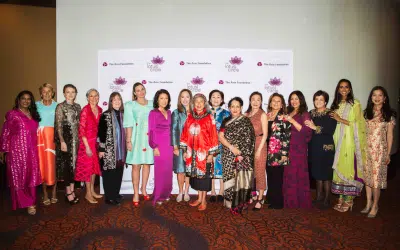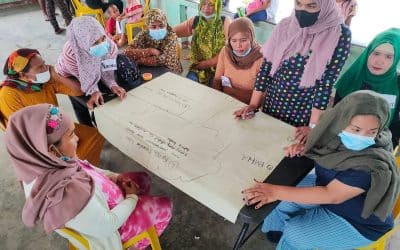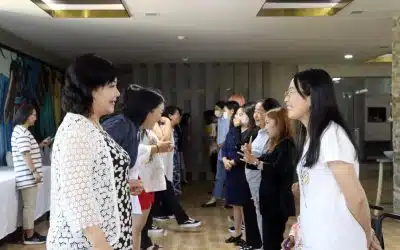InAsia
Insights and Analysis
Myanmar Peace at a Crossroads in 2020
September 30, 2020
As the National League for Democracy closes its first term in government this year, peacebuilding in Myanmar is at a crossroads. The Nationwide Ceasefire Agreement (NCA) represents the most ambitious attempt to date to reach a comprehensive peace agreement, yet, since its signing in 2015, levels of violence in some communities have been higher than ever before, and formal peace negotiations have excluded key actors in Myanmar’s ongoing conflicts in the northeast and west.

Supporters gathered outside NLD party headquarters in Yangon on Election Day, 2015. As the NLD’s first term draws to a close, peacebuilding in Myanmar is at a crossroads.
No breakthroughs at UPC 2020
The fourth Union Peace Conference (UPC or “Panglong Conference”), held in Nay Pyi Taw August 19–21, culminated the latest cycle of the Framework for Political Dialogue. A Panglong is meant to be an opportunity for NCA parties to present and agree to proposals, which together make up the Union Peace Accord. The agreements are signed in a ceremonial show of unity-in-diversity and have been celebrated in effusive speeches by key peace negotiators and national elites.
But many in Myanmar feel that the NCA peace process has failed to deliver real solutions, especially after two years of deadlock since the last UPC, in July 2018. After a meeting that year in October, there was a severe break in relations between negotiators of the Tatmadaw (the Myanmar military) and the NCA-signatory ethnic armed organizations (EAOs), as the two sides could not agree on the ceasefire “package deal” for future security scenarios. Soon afterwards, the Karen National Union (KNU) and the Restoration Council of Shan State (RCSS)—the two largest EAOs and key leaders of their side of the negotiations—temporarily pulled out of the talks. The space for dialogue to expand the Union Peace Accords shrank. There has been little progress since then in translating the 37 principles already agreed upon into action, and they remain largely aspirational and symbolic.
This year’s Panglong was much smaller than previous affairs. Representatives from all 10 NCA-signatory EAOs participated. The government also issued invitations to seven EAOs that it is courting to sign the NCA, including groups from Kachin (KIA), Wa (UWSA), Kokang (MNDAA), Mong La (NDAA), and Shan (SSPP) in the northeast. All declined to participate, however, due to the exclusion of their ally, the Arakan Army (AA), which the government has labeled a terrorist organization and excluded from the peace process.
Two “achievements” were reported from this year’s event: the adoption of a further 20 principles for the Union Peace Accords, and an agreement among the parties to continue formal peace talks with the incoming government. The 20 points, put forth by the Tatmadaw, do not represent breakthroughs that will actually end the continuing hostilities with the signatory EAOs, nor does the EAOs’ acquiescence to these new proposals break new ground for future compromise. Like the previous 37 principles, these new additions are hamstrung by vague language and offer no roadmap for implementation. From the EAO perspective, the most useful outcome of the talks was undoubtedly the signal that the government would continue peace talks after the election. Many observers of the process are wondering what this next iteration will look like.
What prospects for peace in the next term?
With another election approaching, conflict increasing, and instability compounded by Covid-19, this is a crucial time to reimagine a future peace in Myanmar and how to achieve it. Going all-in on the NCA has not produced the constructive change that most parties expected. So, what might be a productive new tack?
A key difference between the current government’s first and last days in office is the changed cast and roles of Myanmar’s nonstate armed groups. In 2020, the deadliest fighting involves EAOs that are not part of the NCA, leaving the peace process powerless against the violence that affects the most civilians. The need to bring these EAOs into talks, inside or outside the NCA, has never been greater.
Rakhine State must also be resituated in the peacebuilding discussions. Ostracizing the AA as a “terrorist organization” rather than an EAO, labeling the conflict in Rakhine as “communal violence,” and reframing peacebuilding work as “social cohesion” serve only to isolate this region from national discussions of ethnic rights and the conditions for peace. So long as communities in Rakhine have no formal way to seek protection, express their grievances, and pursue dialogue, reducing violence will remain an elusive goal.

Myanmar soldier with rifle. In 2020, the deadliest fighting involves EAOs that are not part of the NCA, leaving the peace process powerless against the violence that affects the most civilians. (Photo: Warin Keawchooku / Shutterstock.com)
Improving the public institutions that support the peace process would be a positive step. Replacing the Myanmar Peace Centre with the National Reconciliation and Peace Centre (NRPC) in 2015 disrupted long-standing relationships between official negotiators and EAO leaders. It has taken years for the new NRPC staff to achieve a productive rapport. Meanwhile, since its inception in 2015, the Joint Ceasefire Monitoring Committee has been unable to fulfill its mandate to monitor and report breaches of the accord. The committee remains highly centralized, detached from realities on the ground, and unable to respond to individual monitoring reports. Improving the capacity of these bodies to work effectively with EAOs and communities in conflict-affected areas would go a long way toward building trust in the peace process.
Since NCA negotiations began, ethnic communities have been anticipating concrete policy discussions of their specific grievances, but they have seen little more from the Tatmadaw than an obdurate refusal to venture beyond the current constitution and the NCA. The incoming government will have a real opportunity to ramp up its leadership of the peace process and demonstrate its commitment to ending hostilities.
In the midst of this unpredictable situation, The Asia Foundation’s Peace and Transitions Team in Myanmar is adjusting its own strategies to find a way forward. First and foremost, we are increasing the range of participants in our Policy Dialogues for Peace, reaching out to groups outside the formal NCA process as well as inside, including local political parties, members of civil society, and national think tanks. This initiative convenes policy discussions among conflict parties and supports them with training on current governance structures in Myanmar and envisioning future scenarios, giving them tools to negotiate pragmatically and effectively. The first iteration of this initiative focused on fiscal decentralization and federalism. This year, it will expand to include the political and administrative dimensions of subnational governance that are key to equitable power-sharing, distribution of resources, and representation in public decision-making, issues at the heart of many conflict-affected communities’ grievances.
Tabea Campbell Pauli is an advisor to The Asia Foundation’s Peace and Transitions Program in Myanmar. She can be reached at [email protected]. The views and opinions expressed here are those of the author, not those of The Asia Foundation.
About our blog, InAsia
InAsia is posted and distributed every other Wednesday evening, Pacific Time. If you have any questions, please send an email to [email protected].
Contact
For questions about InAsia, or for our cross-post and re-use policy, please send an email to [email protected].The Asia Foundation
465 California St., 9th Floor
San Francisco, CA 94104
The Latest Across Asia
Program Snapshot
May 2, 2024
News
April 25, 2024
Program Snapshot
April 18, 2024

2024 Lotus Leadership Awards
The Lotus Leadership Awards recognize contributions towards gender equality in Asia and the Pacific







0 Comments